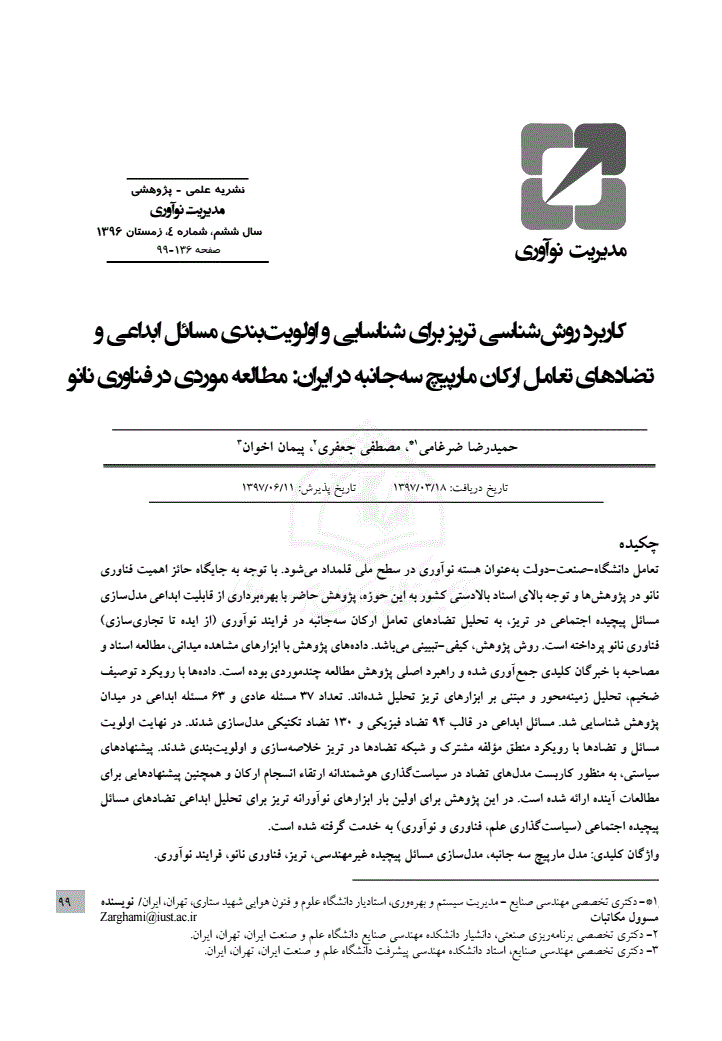چکیده:
تعامل دانشگاه-صنعت-دولت به عنوان هسته نوآوری در سطح ملی قلمداد میشود. با توجه به جایگاه حائز اهمیت نانو در پژوهشها و توجه بالای اسناد بالادستی کشور به این حوزه، در این پژوهش با بهرهبرداری از قابلیت ابداعی مدلسازی مسائل پیچیده اجتماعی در تریز، به تحلیل تضادهای تعامل ارکان سهجانبه در فرایند نوآوری (از ایده تا تجاریسازی) فناوری نانو پرداخته شده است. روش پژوهش کیفی – تبیینی میباشد. دادههای پژوهش با ابزارهای مشاهده میدانی، مطالعه اسناد و مصاحبه با خبرگان کلیدی جمعآوری شده است. استراتژی اصلی پژوهش مطالعه چندموردی بوده است و دادهها با رویکرد توصیف ضخیم، تحلیل تماتیک و مبتنی بر ابزارهای تریز تحلیل شدهاند. تعداد 37 مسئله عادی، 63 مسئله ابداعی در میدان پژوهش شناسایی شد. مسائل ابداعی در قالب 94 تضاد فیزیکی و 130 تضاد تکنیکی مدلسازی شدند. در نهایت اولویت مسائل و تضادها با رویکرد منطق پارامتر مشترک و شبکه تضادها در تریزخلاصهسازی و اولویت بندی شدند. پیشنهادهای سیاستی به منظور کاربست مدلهای تضاد در سیاستگذاری هوشمندانه ارتقای انسجام ارکان و پیشنهاد پژوهشهای متعددی برای آینده ارائه شده است. در این پژوهش برای اولین بار ابزراهای نوآورانه تریز برای تحلیل ابداعی تضادهای مسائل پیچیده اجتماعی (سیاستگذاری علم، فناوری و نوآوری) به خدمت گرفته شده است.
The University-industry-government (UIG) interaction is now seen as the nucleus of innovation at the national level. Considering the importance of the nanotechnology in research and attention paid to the upstream documents of the country in this domain, the current study by exploiting the innovative capability of modelling complex social problems in TRIZ methodology, has analyzed the contradictions between interactions of the three pillars in the process of nanotechnology innovation. The research method is qualitative and explanatory; research data were gathered using field observation tools, study documents and conducting interviews with key experts, and the main research strategy was a multidimensional type. The data analyzed using thick description approach based on TRIZ methodology. Thirty seven normal and sixty three innovative issues were identified in current research. Innovative issues were modeled into ninety four physical contradictions (PC) and hundred and thirty technical contradictions (TC). Finally, the study used TRIZ for the explanation of the issues/problems and contradiction among TH actors, for the first time. As this study used an in-depth approach for this purpose, the results shed lighted on many ways for further theoretical and applied studies in the TRIZ and science, technology and innovation (STI) policy fields of study.

(پژوهیار,
,
,
)

